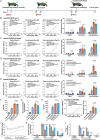Administration of antigenically distinct influenza viral particle combinations as an influenza vaccine strategy
- PMID: 39841684
- PMCID: PMC11753672
- DOI: 10.1371/journal.ppat.1012878
Administration of antigenically distinct influenza viral particle combinations as an influenza vaccine strategy
Abstract
One approach for developing a more universal influenza vaccine is to elicit strong immune responses against canonically immunosubdominant epitopes in the surface exposed viral glycoproteins. While standard vaccines typically induce responses directed primarily against mutable epitopes in the hemagglutinin (HA) head domain, there are generally limited or variable responses directed against epitopes in the relatively more conserved HA stalk domain and neuraminidase (NA) proteins. Here we describe a vaccine approach that utilizes a combination of wildtype (WT) influenza virus particles along with virus particles engineered to display a trimerized HA stalk in place of the full-length HA protein to elicit both responses simultaneously. After initially generating the "headless" HA-containing viral particles in the A/Hawaii/70/2019 (HI/19) genetic background and demonstrating the ability to elicit protective immune responses directed against the HA-stalk and NA, we co-formulated those virions with unmodified WT viral particles. The combination vaccine elicited "hybrid" and protective responses directed against the HA-head, HA-stalk, and NA proteins in both naïve and pre-immune mice and ferrets. Collectively, our results highlight a potentially generalizable method combining viral particles with differential antigenic compositions to elicit broader immune responses that may lead to more durable protection from influenza disease post-vaccination.
Copyright: © 2025 Zhu et al. This is an open access article distributed under the terms of the Creative Commons Attribution License, which permits unrestricted use, distribution, and reproduction in any medium, provided the original author and source are credited.
Conflict of interest statement
I have read the journal’s policy and the authors of this manuscript have the following competing interests: Duke University has filed for IP protection of the antigen designs and the vaccine platform described in this work.
Figures





Similar articles
-
Headless hemagglutinin-containing influenza viral particles direct immune responses toward more conserved epitopes.J Virol. 2024 Oct 22;98(10):e0116624. doi: 10.1128/jvi.01166-24. Epub 2024 Sep 26. J Virol. 2024. PMID: 39324791 Free PMC article.
-
Influenza virus-like particles elicit broader immune responses than whole virion inactivated influenza virus or recombinant hemagglutinin.Vaccine. 2007 May 10;25(19):3871-8. doi: 10.1016/j.vaccine.2007.01.106. Epub 2007 Feb 15. Vaccine. 2007. PMID: 17337102
-
Elicitation of Protective Antibodies against 20 Years of Future H3N2 Cocirculating Influenza Virus Variants in Ferrets Preimmune to Historical H3N2 Influenza Viruses.J Virol. 2019 Jan 17;93(3):e00946-18. doi: 10.1128/JVI.00946-18. Print 2019 Feb 1. J Virol. 2019. PMID: 30429350 Free PMC article.
-
Influenza H3 hemagglutinin vaccine with scrambled immunodominant epitopes elicits antibodies directed toward immunosubdominant head epitopes.mBio. 2023 Aug 31;14(4):e0062223. doi: 10.1128/mbio.00622-23. Epub 2023 Jul 19. mBio. 2023. PMID: 37466314 Free PMC article.
-
Live-attenuated pandemic H1N1 influenza vaccines expressing computationally optimized broadly reactive antigens (COBRAs) are immunogenic and protective in mice and ferrets.Vaccine. 2025 Apr 19;53:127090. doi: 10.1016/j.vaccine.2025.127090. Epub 2025 Apr 4. Vaccine. 2025. PMID: 40186991
References
-
- Paget J, Spreeuwenberg P, Charu V, Taylor RJ, Iuliano AD, Bresee J, et al.. Global mortality associated with seasonal influenza epidemics: new burden estimates and predictors from the GLaMOR Project. J Glob Health. 2019;9(2):020421. doi: 10.7189/jogh.09.020421 ; PMCID: PMC6815659 - DOI - PMC - PubMed
-
- Palese P, Shaw M. Fields virology. In Orthomyxoviridae: the viruses and their replication. 5th ed, Philadelphia (PA): Lippincott Williams & Wilkins, Wolters Kluwer Business; 2007. p. 1647–89.
MeSH terms
Substances
LinkOut - more resources
Full Text Sources
Medical

